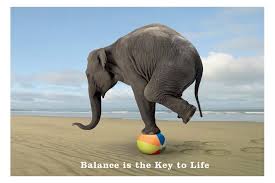 Even successful people get out of balance. In my work coaching professional women I have found a consistent request for the magic solution for juggling the many priorities in one day. I cannot tell you how many times I have heard the following statement: “By the time I get home from work, I feel exhausted. I have more work to do and no energy left over to give to my family.” Women sometimes refer to their lives as a juggling act, keeping several roles in balance: business roles, family roles, social or volunteer roles. And women are very good at multitasking. At first glance, juggling multiple priorities is about holding all of those balls in the air. But that is not the real success strategy. The art of juggling is about making choices about how we spend our time. It is also about making decisions about what is most important.
Even successful people get out of balance. In my work coaching professional women I have found a consistent request for the magic solution for juggling the many priorities in one day. I cannot tell you how many times I have heard the following statement: “By the time I get home from work, I feel exhausted. I have more work to do and no energy left over to give to my family.” Women sometimes refer to their lives as a juggling act, keeping several roles in balance: business roles, family roles, social or volunteer roles. And women are very good at multitasking. At first glance, juggling multiple priorities is about holding all of those balls in the air. But that is not the real success strategy. The art of juggling is about making choices about how we spend our time. It is also about making decisions about what is most important.
What is urgent is not necessarily what is important. Sometimes what you feel is deeply important in your life and what you are doing with your time does not match. In the workplace it is easy to get caught-up in the sense of urgency. When someone knocks at the office door and says “I need this now” it can be difficult to stop the adrenaline flow, so you react. Before long, you are moving from one reaction to the next. If life pulls you from one urgent situation to another, you can forget what is most important. When an infant cries, you know the baby needs immediate attention. This is because the need of the baby is urgent and important. However, when the work you do is constantly crying for attention it may be time to create more balance in your life.
Regardless of how well you adapt, if your responsibilities are making you feel overwhelmed, it is time to find strategies that fit with your values. Striking a balance between work and personal life is a constant challenge. The goal is not to do as much as possible in one day, but to get the most enjoyment out of the moments of the day. Time management is more than doing things right, it is doing the right things. It is more than a to do list and calendars. It involves taking time to prioritize and plan. We need more than a clock in today’s world, we need a compass. The clock is our commitments, appointments, schedules, and activities. It is what we do with our time, how we manage. The compass is how we lead our lives, what we feel is important (Covey, 1994). The compass is our direction. It is our vision, principles and our mission. In order to strike the balance you must start at the beginning and prioritize. Writing down your values and your mission statement comes first. The mission statement is your solid expression of your vision and values. It becomes the criteria by which you measure everything else in your life.
10 Tips for Balance
1. Begin at the beginning. Write down your values and your mission statement.
2. Write down your goals. Goals are overall long term directions. They are specific, measurable, and obtainable, within a certain time.
3. Break down larger goals into meaningful objectives. Objectives are the actions to achieve the goals. Fit these important objectives into your schedule.
4. Plan monthly objectives and have beginning and ending dates.
5. Plan weekly and don’t set impossible standards.
6. Build in flextime for interruptions.
7. Pace yourself and learn to delegate.
8. Learn to say no.
9. Put fun and renewal into each day.
10. Learn how to maintain your energy.
“Run your day by the clock and your life with a vision.”
Zig Ziglar
What are some of your strategies for maintaining balance?
© 2015, Carol-Anne Minski, PhD




